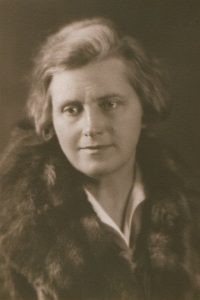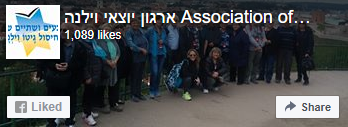Sofija Kymantaitė-Čiurlionienė
 Sofija Čiurlionienė née Kymantaitė (1886–1958) was a Lithuanian writer, educator, and activist.
Sofija Čiurlionienė née Kymantaitė (1886–1958) was a Lithuanian writer, educator, and activist.
After studies at girls' gymnasiums in Saint Petersburg and Riga, she studied philosophy, literature, art history at the Higher Courses for Women and Jagiellonian University. She returned to Lithuania in 1907 and joined the cultural life of Vilnius. In January 1909, she married painter and composer Mikalojus Konstantinas Čiurlionis, but he died in April 1911 leaving her with an infant daughter. Until the start of World War I, she taught Lithuanian language and literature at teachers' courses established by the Saulė Society in Kaunas. She lectured at the Vytautas Magnus University from 1925 to her retirement in 1938. Čiurlionienė was also active in public life – she was a delegate to the Assembly of the League of Nations in 1929–1931 and 1935–1938, leader of the Lithuanian girl scouts in 1930–1936, an active participant in various women's organizations, including the Women's International League for Peace and Freedom and the Lithuanian Women's Council. During World War II, she helped save Jews from the Kovno Ghetto and was recognized as Righteous Among the Nations in 1991.
In her essays on art and literature, influenced by ideas of fin de siècle and Young Poland movements, she criticized realism and supported symbolism. However, some of her own literary works are good examples of realism. Her most popular works are theater plays, in particular comedies Pinigėliai (Money; 1919) and Vilos puošmena (Decoration of a Villa; 1932). She also wrote dramas, plays for school theaters, poems. Most of her novels explore the Lithuanian press ban and the Lithuanian National Revival.
Kymantaitė was born to a family of a landless Lithuanian noble on 13 March 1886 in the clergy house in Joniškis. The family lived with her maternal uncle Catholic priest Vincentas Jarulaitis who taught her privately and sponsored her education. When her parents' business, a guest house and a small shop in Šiauliai failed, the family moved back to live with Jarulaitis in Kuliai in 1893. In 1898, she enrolled into a primary girls' school in Palanga. The same year, Kymantaitė met priest Juozas Tumas-Vaižgantas, an active participant in the Lithuanian National Revival and editor of Tėvynės sargas, who was assigned to Kuliai. He taught her to read and write in the Lithuanian language. In 1899, she saw America in the Bathhouse, the first Lithuanian-language play in present-day Lithuania. In 1899–1904, Kymantaitė studied at the girls' gymnasium attached to the Catholic Church of St. Catherine in Saint Petersburg, at a private girls' school and a public girls' gymnasium in Riga. In Riga, she participated in a secret Lithuanian student society established by Kipras Bielinis. Marcelinas Šikšnys continued to teach her Lithuanian. She also frequently visited the family of writer Pranas Mašiotas and read her first poems.
In 1904–1907, she studied in Kraków (then part of Austria-Hungary) at the Higher Courses for Women established by Adrian Baraniecki and the Jagiellonian University. She initially hoped to study medicine, but she did not know Latin and instead studied philosophy, literature, art history. In Kraków, she met such Polish painters as Piotr Stachiewicz and Franciszek Turek ; her teachers included Konstanty Górskior art history and Lucjan Rydel for literature. She also joined the Rūta Society, a Lithuanian society established by Józef Albin Herbaczewski , and started writing articles on Lithuanian literature. Her first longer study on poets Antanas Vienažindys , Maironis, and Pranas Vaičaitis was published by Vilniaus žinios in December 1906.
When her uncle Jarulaitis suffered a fire and could no longer support her education, Kymantaitė returned to Lithuania and joined the cultural life of Vilnius in 1907. Encouraged by Juozas Tumas-Vaižgantas, she took a job at the office of Viltis (Hope) and contributed articles and feuilletons on Lithuanian literature. She received further lessons in Lithuanian from Tumas-Vaižgantas, Jonas Jablonskis, Jurgis ŠlapelisShe participated at the First Congress of Lithuanian Women in September 1907. Together with Marija Pečkauskaitė, she was selected as vice-chair for the event. Kymantaitė delivered a speech on teaching the history of Lithuania and was elected to a 10-person committee charged with the establishment of the Lithuanian Women's Union. She also participated in the activities of the Rūta Society; for example, she performed the main female role of Aldona in the historical play Mindaugas by Juliusz Słowacki in May 1908.
She met her future husband Mikalojus Konstantinas Čiurlionis at the opening of the First Lithuanian Art Exhibition in January 1907. At the time, she was engaged to Zygmunt Ruszczyc, a manor owner from Širvintos. Kymantaitė and Čiurlionis met again in November 1907 at an event commemorating Vincas Kudirka during which she delivered a speech and he played a piano. After the event, he asked her to teach him Lithuanian. She agreed, teaching him three times a week using a Lithuanian grammar by Jonas Jablonskis and a Lithuanian folk song collection by Antanas Juška. In summer 1908, they spent some time in Palanga and then visited their families in Plungė and Druskininkai to inform them about their engagement. They wed on 1 January 1909 in Šateikiai. The couple departed to Saint Petersburg to further Čiurlionis' artistic career. They returned to Lithuania to spend the summer in Druskininkai, Vilnius, and Plungė. In fall 1909, Čiurlionis returned alone to Saint Petersburg. When Čiurlionienė visited him around Christmas, she found him in deep depression and barely aware of his surroundings. He was placed in a sanatorium in Marki near Warsaw. She remained in Lithuania and gave birth to their daughter Danutė on 12 June 1910. Čiurlionis never saw his daughter – he caught cold, developed pneumonia, and died on 10 April 1911 in Marki.
During their short relationship, the couple worked on a few joint projects – organized the Second Lithuanian Art Exhibition, published a collection of literary criticism Lietuvoje (In Lithuania; 1910), painted a backdrop for the Rūta Society (she painted tulip ornaments in the Lithuanian folk style), and worked on an unfinished opera Jūratė. They both had a artistic strong influence on one another. The paintings of Čiurlionis received universal acclaim in Lithuania and the government founded the M. K. Čiurlionis National Art Museum in 1921. In 1922, Čiurlionienė agreed to sell 193 works by Čiurlionis for 65,000 German gold marks to the government. However, the money was put into a trust for the benefit of their daughter until she turned 21.
Čiurlionienė continued to be active in public life. In March 1929, she attended a meeting on the situation in Eastern Europe organized by the Women's International League for Peace and Freedom (WILPF) in Vienna. Her efforts to defend Lithuania's territorial claims to Vilnius Region received praise in Lithuania and she was sent to the 6th congress of WILPF in Prague in August 1929. She also became a member of the Lithuanian government delegations to the Assembly of the League of Nations in 1929–1931 and 1935–1938. The other two members of the 1929 delegation were Prime Minister Augustinas Voldemaras and diplomat Vaclovas Sidzikauskas. In 1930, she joined the League's Fifth Committee which dealt with social and humanitarian questions such as human trafficking, prostitution, children's welfare.In Switzerland, she learned about the Union of Friends of Young Women (French: Union internationale des Amies de la jeune fille) established in 1877 and founded its chapter in Lithuania (Mergaičių bičiulių draugija) in 1929. The union sought to help young women who moved from villages to larger cities to avoid being exploited or trafficked. In 1935, Čiurlionienė returned to the League and became a member of the Fist Committee (legal and constitutional questions) and Sixth Committee (mandates, slavery and political questions), but returned to the Fifth Committee in 1936. In 1937, participated in the Second Congress of Lithuanian Women organized by the Lithuanian Women's Council where she read a paper on the causes for marriage failures. The Lithuanian Women's Council unsuccessfully suggested her to the State Council of Lithuania and to run as a candidate to the Fourth Seimas.
In 1930–1936, she was the leader of the Lithuanian girl scouts. From around 1926 to 1942, she organized Saturday gatherings in her home that attracted famous writers, poets, linguists. Frequent visitors included Vincas Mykolaitis-Putinas, Balys Sruoga, Salomėja Nėris, Kostas KorsaksThese gatherings resulted in the magazine Gimtoji kalba (Mother Tongue; 1933–1941) which was edited by Čiurlionienė for the first year. She also published numerous articles on language, education, and culture in various periodicals.
Due to poor health, she resigned from her teaching position in 1938, but continued to be active delivering guest lectures. During World War II, together with her daughter and son-in-law, she helped rescue Esther, one-year old daughter of the Jewish writer Meir Jelin . They worked with Petras Baublys, director of an orphanage, and saved children and others from the Kovno Ghetto. They were recognized as Righteous Among the Nations in 1991.
In 1954, Čiurlionienė petitioned Justas Paleckis, Chairman of the Supreme Soviet of the Lithuanian SSR, on behalf of Juozas Urbšys, the last Minister of Foreign Affairs of independent Lithuania, and his wife Marija Mašiotaitė-Urbšienė, childhood friend of Čiurlionienė and daughter of writer Pranas Mašiotas. Urbšys had served a prison sentence in Siberia but was not allowed to return to Lithuania. Čiurlionienė asked Paleckis to allow them to return and promised to house them at her home. They returned in 1956 and lived with Čiurlionienė. To earn some money, Urbšys translated from French to Lithuanian. In public, these translations were attributed to Čiurlionienė. One of such translations was the novel Madame Bovary by Gustave Flaubert published in 1958.
Čiurlionienė suffered two heart attacks and died in 1958. She was buried in the Petrašiūnai Cemetery.
From: Wikipedia

